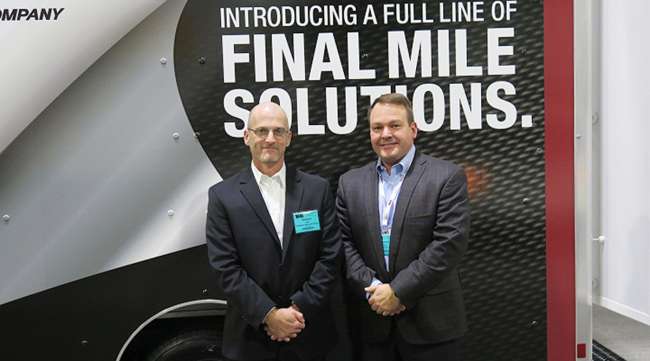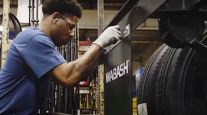Senior Reporter
Wabash Readies for More Advanced Composite Technology

ATLANTA — Wabash National Corp., the nation’s top supplier of trailers, is renewing its trailer and truck body design using advanced composite panels to add strength, increase thermal efficiency and save weight, company executives said.
Two such semitrailers and one truck body from Wabash, a leading North American trailer manufacturer, were exhibited at the annual meeting and exposition of the Technology & Maintenance Council.
The council is a division of American Trucking Associations.
The company is trying to move past just simple features and applications “to really understand how we can dramatically change the form and function of a trailer,” Wabash President Brent Yeagy told Transport Topics during the event.
He is expected to become CEO in a few months.
Nearby, one of its molded composite reefer trailers was on display.
Robert Lane, vice president of engineering at Wabash, touched its side and said there was no metal inside the roof, nose, walls or floor and yet the trailer has a 24,000-pound floor rating — the standard reefer floor is rated at 16,000 pounds.
Yeagy said the strength of the floor gives the reefer trailer the capabilities of a dry van, which is useful for expanding the options for backhauls and increasing efficiency.
At the same time, the thermal efficiency is 28% better than the same reefer trailer built conventionally, Lane said.
Werner Enterprises Inc. is fleet-testing the trailer. The company ranks No. 16 on the Transport Topics Top 100 list of the largest for-hire carriers in North America.
Next to that trailer was a DuraPlate Cell Core dry van that is 300-350 pounds lighter than a standard DuraPlate trailer equally equipped — thanks to the new panels that have the strength of the current panel.
“This is our next step in weight reduction on the dry van product,” Lane said, and it has been in real-world test for four years.
Cell Core trailers will be available for fleets to order beginning in model year 2019.
“Just to be clear,” Yeagy added, “It is not just a simple mechanical solution in the sidewall itself. This is really about advanced materials science coming to bear within the basic trailer design, and one of first steps in the next generation of composite panel technology [in the sidewalls of the trailer].”
Lane said there will be some patents connected to the process.
Wabash has been using composites since it launched its DuraPlate model in 1996, the industry’s first composite plate trailer.
Across the way stood a trailer intended for final-mile delivery. It featured bonded DuraPlate sidewalls over a honeycomb core. The process eliminates posts and leak points, according to the company.
Bonding is a highly controlled, semiautomated process, Yeagy said. “A modern way to join materials.”
Wabash looked at how the airline industry bonds aircraft fuselages and brought that back to the trailer industry and used it to bond sidewalls, noses and roof materials beginning 10 years ago.
“There is pressure involved, temperature, time and a level of plasma treating we tend to do. That is what gives trust to the industry to begin to move to a hi-tech bonded panel,” Yeagy said.
The bonded surface is smoother for application of large decals, too. Plus, the riveting process is extremely loud, so bonding has reduced the noise level in the plant.
“And as we continue to move down the bonding path. I want to bond it all,” Lane said.
Meanwhile, Yeagy said he could not be “more humbled and excited” to be in line to become the company’s next CEO in June.
“I have been here for 15 years and what we have done in that time is impressive, but I think there is so much more that we can do. We have great people and coupled with our ability to innovate, it’s just an exciting place to be,” he said.
Asked about President Donald Trump’s announced intention to increase tariffs 25% on steel and 10% on aluminum, Yeagy said if they went into effect it would add more material inflation into general manufacturing.
Domestic steel and aluminum manufacturers will raise prices, he said, “and they should try to take as much pricing as they could. That’s simple economics.”



